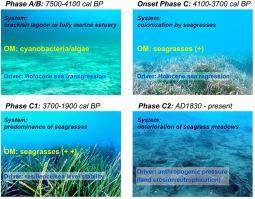当前位置:
X-MOL 学术
›
Palaeogeogr. Palaeoclimatol. Palaeoecol.
›
论文详情
Our official English website, www.x-mol.net, welcomes your feedback! (Note: you will need to create a separate account there.)
Reconstruction of 7500 years of coastal environmental change impacting seagrass ecosystem dynamics in Oyster Harbour (SW Australia)
Palaeogeography, Palaeoclimatology, Palaeoecology ( IF 3 ) Pub Date : 2020-11-01 , DOI: 10.1016/j.palaeo.2020.109953 Joeri Kaal , Paul S. Lavery , Antonio Martínez Cortizas , Olalla López-Costas , Teresa Buchaca , Cristian Salinas , Oscar Serrano
Palaeogeography, Palaeoclimatology, Palaeoecology ( IF 3 ) Pub Date : 2020-11-01 , DOI: 10.1016/j.palaeo.2020.109953 Joeri Kaal , Paul S. Lavery , Antonio Martínez Cortizas , Olalla López-Costas , Teresa Buchaca , Cristian Salinas , Oscar Serrano

|
Abstract Seagrass ecosystems, which have important functions such as coastal protection and blue carbon sequestration, are threatened by anthropogenic pressure including climate change. Long-term data series from seagrass sedimentary archives (mats) can be used to understand natural cycles of environmental change and answer key questions related to contemporary management. A 7500 yr sediment record from Posidonia australis meadows in Oyster Harbour (Albany, SW Australia) was subjected to multiproxy reconstruction by means of pigment analysis (UHPLC), analytical pyrolysis (Py-GC–MS), carbonate content, δ13C and δ15N stable isotope ratios, organic C (Corg) content, Corg/N ratio and glomalin-related soil proteins (GRSP). The study revealed a brackish lagoon (7500–7000 cal yr BP) that was transformed in an open marine environment (7000–4100 cal yr BP) due to Holocene transgression. Earliest evidence of seagrass establishment was detected around 4500 cal yr BP, and meadow extension accelerated between 4100 and 3700 cal yr BP. The meadow environment was surprisingly resistant against environmental perturbations, as the mat, composed of P. australis seagrass fibres embedded within a siliciclastic mineral matrix containing biogenic carbonates, continued to develop steadily until 190 cal yr BP (1830 CE). Then, shifts in several proxies (pigments, GRSP) showed evidence of terrestrial runoff-triggered eutrophication/turbidity (likely driven by forest clearance and agricultural activities after European settlement), but the seagrass showed resilience (no decline of the proportion of seagrass-derived Corg). By contrast, since ~1930 CE seagrass retreat is evident in the biogeochemical record: lighter δ13C values, lower lignin abundance and shifts in pigment abundance and types, affecting the balance between seagrass inputs and alternative sources, as was observed in previous studies of the area. The findings show that pigment proxies are useful early indicators of shifts in seagrass ecosystem condition, while lignocellulose and other pyrolysis products are useful proxies of more profound ecosystem alterations that influence seagrass abundance. The record indicates that the climax seagrass ecosystem condition, which prevailed for several millennia, had been impacted over the last century. Management of seagrass and coastal ecosystems should aim to avoid crossing ecological thresholds and diminish local impacts aggravating those of global change.
中文翻译:

重建 7500 年来影响牡蛎港(澳大利亚西南部)海草生态系统动态的沿海环境变化
摘要 海草生态系统具有海岸保护、蓝碳固存等重要功能,受到气候变化等人为压力的威胁。来自海草沉积档案(垫)的长期数据系列可用于了解环境变化的自然循环并回答与当代管理相关的关键问题。通过色素分析 (UHPLC)、分析热解 (Py-GC-MS)、碳酸盐含量、δ13C 和 δ15N 稳定同位素,对牡蛎港(澳大利亚西南部奥尔巴尼)的 Posidonia australis 草甸的 7500 年沉积物记录进行多代理重建比率、有机碳 (Corg) 含量、Corg/N 比率和球藻蛋白相关土壤蛋白质 (GRSP)。该研究揭示了一个半咸水泻湖(7500-7000 cal yr BP),由于全新世海侵而在开放海洋环境(7000-4100 cal yr BP)中发生转变。海草生长的最早证据是在 4500 cal BP 左右检测到的,草甸扩张在 4100 cal yr BP 到 3700 cal BP 之间加速。草地环境对环境扰动具有惊人的抵抗力,因为由嵌入含有生物碳酸盐的硅质碎屑矿物基质中的澳大利亚海草纤维组成的垫子继续稳定发展,直到 190 cal yr BP(公元 1830 年)。然后,几个代理(颜料,GRSP)的变化显示了陆地径流引发的富营养化/浑浊的证据(可能由欧洲定居后的森林砍伐和农业活动驱动),但海草表现出弹性(海草来源的 Corg 比例没有下降)。相比之下,自公元 1930 年以来,海草退缩在生物地球化学记录中很明显:δ13C 值较轻,木质素丰度较低,色素丰度和类型发生变化,影响了海草输入和替代来源之间的平衡,正如之前对该地区的研究所观察到的那样. 研究结果表明,色素代理是海草生态系统条件变化的有用早期指标,而木质纤维素和其他热解产物是影响海草丰度的更深刻生态系统改变的有用代理。记录表明,盛行了数千年的高潮海草生态系统状况在上个世纪受到了影响。
更新日期:2020-11-01
中文翻译:

重建 7500 年来影响牡蛎港(澳大利亚西南部)海草生态系统动态的沿海环境变化
摘要 海草生态系统具有海岸保护、蓝碳固存等重要功能,受到气候变化等人为压力的威胁。来自海草沉积档案(垫)的长期数据系列可用于了解环境变化的自然循环并回答与当代管理相关的关键问题。通过色素分析 (UHPLC)、分析热解 (Py-GC-MS)、碳酸盐含量、δ13C 和 δ15N 稳定同位素,对牡蛎港(澳大利亚西南部奥尔巴尼)的 Posidonia australis 草甸的 7500 年沉积物记录进行多代理重建比率、有机碳 (Corg) 含量、Corg/N 比率和球藻蛋白相关土壤蛋白质 (GRSP)。该研究揭示了一个半咸水泻湖(7500-7000 cal yr BP),由于全新世海侵而在开放海洋环境(7000-4100 cal yr BP)中发生转变。海草生长的最早证据是在 4500 cal BP 左右检测到的,草甸扩张在 4100 cal yr BP 到 3700 cal BP 之间加速。草地环境对环境扰动具有惊人的抵抗力,因为由嵌入含有生物碳酸盐的硅质碎屑矿物基质中的澳大利亚海草纤维组成的垫子继续稳定发展,直到 190 cal yr BP(公元 1830 年)。然后,几个代理(颜料,GRSP)的变化显示了陆地径流引发的富营养化/浑浊的证据(可能由欧洲定居后的森林砍伐和农业活动驱动),但海草表现出弹性(海草来源的 Corg 比例没有下降)。相比之下,自公元 1930 年以来,海草退缩在生物地球化学记录中很明显:δ13C 值较轻,木质素丰度较低,色素丰度和类型发生变化,影响了海草输入和替代来源之间的平衡,正如之前对该地区的研究所观察到的那样. 研究结果表明,色素代理是海草生态系统条件变化的有用早期指标,而木质纤维素和其他热解产物是影响海草丰度的更深刻生态系统改变的有用代理。记录表明,盛行了数千年的高潮海草生态系统状况在上个世纪受到了影响。



























 京公网安备 11010802027423号
京公网安备 11010802027423号